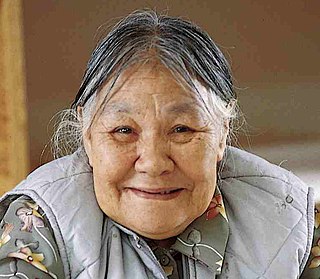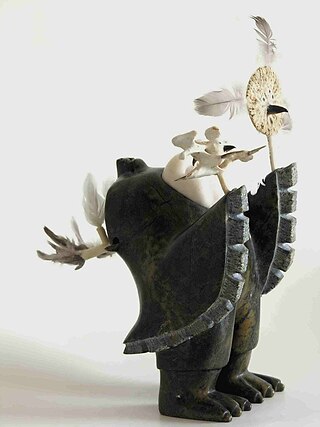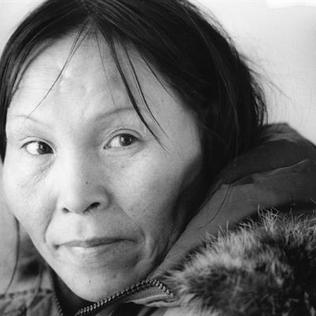Related Research Articles

Pitseolak Ashoona was an Inuk Canadian artist admired for her prolific body of work. She was also a member of the Royal Canadian Academy of Arts.

Kenojuak Ashevak,, is celebrated as a leading figure of modern Inuit art.

Kinngait, formerly known as Cape Dorset until 27 February 2020, is an Inuit hamlet located on Dorset Island near Foxe Peninsula at the southern tip of Baffin Island in the Qikiqtaaluk Region of Nunavut, Canada.

Annie Pootoogook was a Canadian Inuk artist known for her pen and coloured pencil drawings. In her art, Pootoogook often portrayed the experiences of those in her community of Kinngait, in northern Canada, and memories and events from her own life.

Inuit art, also known as Eskimo art, refers to artwork produced by Inuit, that is, the people of the Arctic previously known as Eskimos, a term that is now often considered offensive. Historically, their preferred medium was walrus ivory, but since the establishment of southern markets for Inuit art in 1945, prints and figurative works carved in relatively soft stone such as soapstone, serpentinite, or argillite have also become popular.

Pudlo Pudlat (Pudlo), was a Canadian Inuit artist whose preferred medium was a combination of acrylic wash and coloured pencils. His works are in the collections of most Canadian museums. At his death in 1992, Pudlo left a body of work that included more than 4000 drawings and 200 prints.
Ningiukulu (Ningeokuluk) Teevee is a Canadian Inuit writer and visual artist.

Janet Kigusiuq was an Inuit artist. Kigusiuq came from a large family of artists: she was the eldest daughter of Jessie Oonark, her siblings included artists Victoria Mamnguqsualuk, Nancy Pukingrnak, Peggy Qablunaaq Aittauq, Mary Yuusipik Singaqti, Josiah Nuilaalik, Miriam Marealik Qiyuk, and William Noah, and she was married to Mark Uqayuittuq, son of Luke Anguhadluq, themselves both artists.

Shuvinai Ashoona is an Inuk artist who works primarily in drawing. She is known for her detailed pen and pencil drawings depicting northern landscapes and contemporary Inuit life.
Pitaloosie Saila was a Canadian Inuk graphic artist who predominantly made drawings and lithograph prints. Saila's work often explores themes such as family, shamanism, birds, and her personal life experiences as an Inuk woman. Her work has been displayed in over 150 exhibitions nationally and internationally, such as in the acclaimed Isumavut exhibition called "The Artistic Expression of Nine Cape Dorset Women". In 2004, Pitaloosie Saila and her well-known husband and sculptor Pauta Saila were both inducted into the Royal Canadian Academy of Arts.

Napachie Pootoogook was a Canadian Inuit graphic artist.
Timootee "Tim" Pitsiulak was an Inuk artist and hunter based in Nunavut, Canada, best known for his large coloured-pencil drawings of Arctic scenery, wildlife, and Inuit culture.
Eleeshushe Parr was an Inuk graphic artist and sculptor, from the Kingnait area, who produced over 1,160 drawings. Her work has been exhibited in Canada, the United States, and Sweden.
Luke Anguhadluq was an Inuit Canadian artist in Baker Lake.
Ikayukta Tunnillie was an Inuit artist in the fields of printmaking and drawing. Tunnillie was born in Nunavut and traveled for much of her life. Tunnillie's work in drawing and printmaking focused on animals and life in the North. She was one of the oldest printmakers to work with the West Baffin Eskimo Co-operative.
Mayureak Ashoona is an Inuit artist, known for her works on paper.
The West Baffin Eskimo Cooperative, also known as the Kinngait Co-operative is an Inuit co-operative in Kinngait, Nunavut best known for its activities in buying, producing and selling Inuit artworks. The co-operative is part of Arctic Co-operatives Limited, a group of locally owned businesses that provide fundamental services in the Canadian north. The co-operative sets prices for the sale of its member's works, pays the artists in advance and shares its profits with its members.

Kiakshuk was a Canadian Inuit artist who worked both in sculpture and printmaking. Kiakshuk began printmaking in his seventies and, is most commonly praised for creating “real Eskimo pictures” that relate traditional Inuit life and mythology.
Nicotye Samayualie is a Canadian Inuk artist from Cape Dorset, Nunavut. Samayualie specializes in drawings of still lifes and landscapes. She often uses large-format drawings to create expansive images of Cape Dorset landscapes.
Sharni Pootoogook (1922–2003) was an Inuit printmaker from Cape Dorset, Nunavut.
References
- ↑ Sandra Martin (2016-12-30). "Tim Pitsiulak created a fresh vision of contemporary Inuit art". The Globe and Mail . Archived from the original on 2018-04-02. Retrieved 2018-04-02.
- ↑ "Ohotaq Mikkigak". National Gallery of Canada . Retrieved 2018-08-29.
- 1 2 3 4 5 6 7 8 9 10 11 12 13 14 "Ohotaq (Oqutaq) Mikkigak (1936-2014)," Spirit Wrestler Gallery, 2013, Accessed March 23, 2018, http://www.spiritwrestler.com/catalog/index.php?artists_id=64 .
- 1 2 3 4 5 6 7 8 9 10 11 12 13 "Ohotaq Mikkigak," Dorset Fine Arts, Accessed March 23, 2018, http://www.dorsetfinearts.com/ohotaq-mikkigak/ .
- 1 2 3 "Ohotaq Mikkigak," DaVic Gallery of Native Canadian Arts, Accessed March 16, 2018, https://nativecanadianarts.com/artist/ohotaq-mikkigak/ .
- ↑ "Exchange: Imaginary Owl". exchange.umma.umich.edu. Retrieved 2020-12-21.
- ↑ "Ohotaq Mikkigak". www.gallery.ca. Retrieved 2020-12-21.
- ↑ "Brooklyn Museum". www.brooklynmuseum.org. Retrieved 2020-12-21.
- ↑ Campbell, Nancy (November 2, 2012). "Inuit Artist Ohotaq Mikkigak Draws on Landscapes of Ice and Memory". Canadian Art. Accessed March 16, 2018.